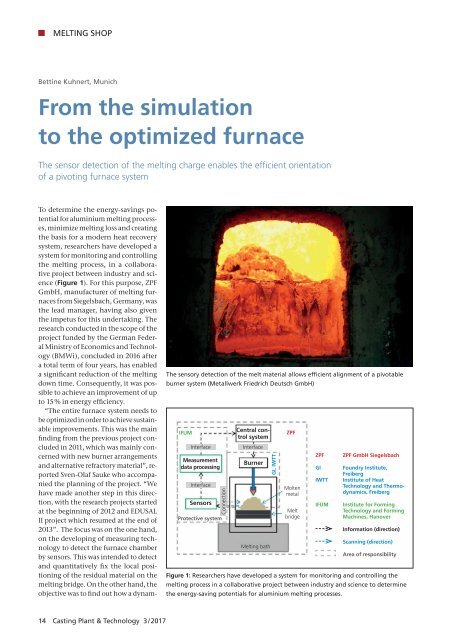CPT International 03/2017
The leading technical journal for the global foundry industry – Das führende Fachmagazin für die weltweite Gießerei-Industrie
The leading technical journal for the
global foundry industry – Das führende Fachmagazin für die
weltweite Gießerei-Industrie
- No tags were found...
Create successful ePaper yourself
Turn your PDF publications into a flip-book with our unique Google optimized e-Paper software.
MELTING SHOP<br />
Bettine Kuhnert, Munich<br />
From the simulation<br />
to the optimized furnace<br />
<br />
of a pivoting furnace system<br />
To determine the energy-savings potential<br />
for aluminium melting processes,<br />
minimize melting loss and creating<br />
the basis for a modern heat recovery<br />
system, researchers have developed a<br />
system for monitoring and controlling<br />
the melting process, in a collaborative<br />
project between industry and science<br />
(Figure 1). For this purpose, ZPF<br />
GmbH, manufacturer of melting furnaces<br />
from Siegelsbach, Germany, was<br />
the lead manager, having also given<br />
the impetus for this undertaking. The<br />
research conducted in the scope of the<br />
project funded by the German Federal<br />
Ministry of Economics and Technology<br />
(BMWi), concluded in 2016 after<br />
a total term of four years, has enabled<br />
a significant reduction of the melting<br />
down time. Consequently, it was possible<br />
to achieve an improvement of up<br />
to 15 % in energy efficiency.<br />
“The entire furnace system needs to<br />
be optimized in order to achieve sustainable<br />
improvements. This was the main<br />
finding from the previous project concluded<br />
in 2011, which was mainly concerned<br />
with new burner arrangements<br />
and alternative refractory material”, reported<br />
Sven-Olaf Sauke who accompanied<br />
the planning of the pro ject. “We<br />
have made another step in this direction,<br />
with the research pro jects started<br />
at the beginning of 2012 and EDUSAL<br />
II project which resumed at the end of<br />
2013”. The focus was on the one hand,<br />
on the developing of measuring technology<br />
to detect the furnace chamber<br />
by sensors. This was intended to detect<br />
and quantitatively fix the local positioning<br />
of the residual material on the<br />
melting bridge. On the other hand, the<br />
objective was to find out how a dynam-<br />
<br />
<br />
IFUM<br />
Interface<br />
Measurement<br />
data processing<br />
Interface<br />
Sensors<br />
Protective system<br />
Connection<br />
Central control<br />
system<br />
Interface<br />
Burner<br />
Melting bath<br />
GI, IWTT<br />
ZPF<br />
Molten<br />
metal<br />
Melt<br />
bridge<br />
Figure 1: <br />
<br />
<br />
ZPF<br />
GI<br />
IWTT<br />
IFUM<br />
ZPF GmbH Siegelsbach<br />
Foundry Institute,<br />
Freiberg<br />
Institute of Heat<br />
Technology and Thermodynamics,<br />
Freiberg<br />
Institute for Forming<br />
Technology and Forming<br />
Machines, Hanover<br />
Information (direction)<br />
Scanning (direction)<br />
Area of responsibility<br />
14 Casting Plant & Technology 3 / <strong>2017</strong>


















